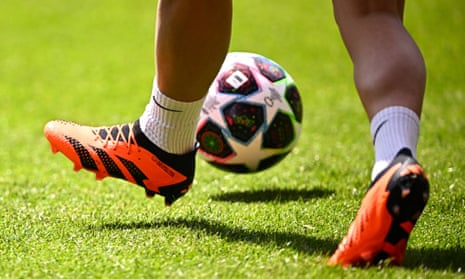A new report has revealed that as many as 82% of the female footballers in Europe that took part in a survey experience discomfort wearing football boots.
The groundbreaking study was coordinated by the European Club Association’s high performance advisory group with industry leading experts from St Mary’s University, Twickenham, and Aspetar, an orthopaedic and sports medicine hospital in Qatar. Around 350 players from across the continent were surveyed for the research.
The ECA’s head of women’s football, Claire Bloomfield, admitted that the sheer number of players that experienced discomfort was the biggest shock. “Those figures were staggering, 82%,” she said. “We knew we were going to find something, but those numbers floored us all.”
Across Europe the ECA found that a fifth of players had resorted to customising their boots, with a majority using specialised insoles, while there were also examples of players attempting to widen the heel by cutting holes in the back of their boots. Of those surveyed, 43.1% of players do not have boot sponsorship and 18% do not select the boots they wear themselves, with clubs, agents, brands or boot websites choosing for them.
In addition to being asked detailed questions about their boots and how they fit, players also underwent a 3D foot scan of both feet that pointed to two distinct foot types with matching tendencies.
Players were only identifiable through their ethnicity and playing position, and the results showed that 48% of black players experienced heel discomfort, compared to an overall average of 33.7%. The study found that there were many similarities between the feet of Caucasian, Hispanic and mixed ethnicity female players, in comparison black and Asian players tend to have larger dorsal midfoot areas, a bigger plantar contact area and larger areas around the achilles.
Dr Katrine Kryger, an expert in football medicine and sports rehabilitation from St Mary’s University, said that while further investigation into this area was needed, “one size doesn’t fit all, and ethnicity plays a part in that too”. Asked whether there was a correlation between inappropriate boots and injuries, with the report having found that two in five players did not feel the current football boot market offers good injury prevention for them, Kryger said: “We don’t have that data yet. We don’t have anything to compare it with.
“We have the men’s research market and we know there are issues related to it, that wrong-fitted football boots can cause problems. One of the things we have said is that we shouldn’t just copy what the men are doing. Just because the men haven’t considered a specific bit of science, doesn’t mean we can’t for women’s football.”
after newsletter promotion
The report will now be submitted for peer review before it is published in full. Bloomfield said: “The end goal is about inspiring industry change. It is highlighting a really key area in neglected research.”
